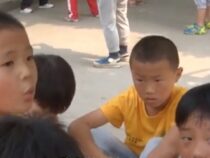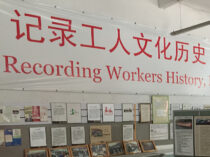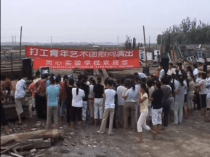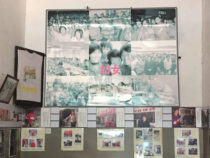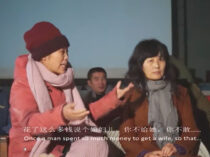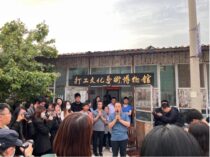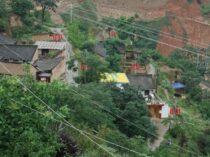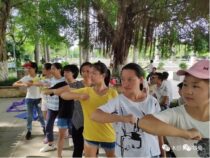Field Notes on Community Projects in d14 and the Role of the Artist
Field Notes on Community Projects in d14 and the Role of the ArtistAris Anagnostopoulos and Elpida Rikou Introductory Note The two texts that follow are responses to select d14 community projects written respectively by anthropologists Aris Anagnostopoulos and Elpida Rikou. The first piece centers on THE ROUND-UP PROJECT: KOKKINIA 1979—KOKKINIA 2017 \ M.Z. \ M.K. (hereafter The Round-Up Project) by Greek artist Mary Zygouri. In early 2017, Aris Anagnostopoulos assisted in the project’s preparations. The second text focuses on the on-going Victoria Square Project (hereafter V.S.P.), an initiative launched by American artist Rick Lowe, the development of which Elpida Rikou observed throughout its first year. Below Anagnostopoulos and Rikou present two separate reflections informed by the field. They left out a wealth of detail in order to jointly publish their texts, thus facilitating the reader to compare the scope, goals, aesthetic choices and engagement of the two, very different projects. Emphasis on community sparked their original interest in both endeavors, but the pivotal role played by the artist captured their attention in the long run. This might indicate a contradiction inherent in the conception of any community project that is considered an artwork signed by an individual artist, a point that they wish to consider more thoroughly in the future. A. THE ROUND-UP PROJECT: KOKKINIA 1979—KOKKINIA 2017 \ M.Z. \ M.K. Aris Anagnostopoulos Mary Zygouri’s Round-Up Project was a hybrid artwork and community project that culminated in both a performance in Nikea, [1] a working-class suburb between Piraeus and Athens on April 9, 2017, as well as a video documentation that was shown in Kassel. [2] The project was based on a past performance (“Kokkinia”) by the artist Maria Karavela that took place on June 27, 1979 in Nikea’s main square. The work had an educational character intended to recall the resistance of left-wing partisans against Nazi troops, suppressed by the official state after WWII. [3] Much of what transpired during the performance is now lost to us after a destructive fire at Karavela’s studio, so the performance itself and its impact on the neighborhood have been reconstructed primarily through newspaper articles, interviews with the artist, and participant testimonies. The research project that led to Zygouri’s performance in 2017 sought to retrace the path taken by Karavela by locating and interviewing people who somehow contributed to or witnessed the 1979 performance. Zygouri focused on the old carpet factory where hundreds of anti-fascist locals were rounded up and executed on August 17, 1944, a site that is currently a museum and monument to the fallen. The artist worked with a group of local high-school pupils and a team of mostly local researchers and artists to performatively approach the “assemblage of memory” created around these events, thus revisiting the uneven archive of testimonies, memories, opinions, affects and aesthetics. [4] Zygouri sought to perform this archive by engaging with its aesthetic and historical import, which she achieved by holding regular workshops with the pupils, conducting historical research and ethnographic observation, and interviewing both participants in Karavela’s performance and key persons in the social and cultural life of Nikea in the recent past. The Round-Up Project divided the audience. It is my impression, in retrospect, that the reception was divided due to the affective content of the archive of images, places, people and emotions that Zygouri’s work addressed, and how she managed this content during the performance. For a more discerning audience, the performance forced its emotional content on the spectator through its excessively loaded imagery by using, for example, colored water to materialize the local memories of blood spilled on the day of the execution in 1944, or by Zygouri hugging a female visitor, unknown to her, who had collapsed in tears during the performance. Significantly, this forcing of sentiment through aesthetic choices is something that Karavela herself was criticised for after her 1979 performance. [5] For others, and especially local participants, this raw sentimental imagery was precisely the strength of the work itself that addressed deeply entrenched political emotions in the area and in Greece at large (meaningfully, some of the latter critics made a sharp distinction between art crowds and next-door people in the reception of the work). [6] For me, the idea that shaped the collaboration was the experimentation with ethnographic work within an artistic process, and indeed I closely followed the work in its preparation in early 2017. My participation tested the limits of my ethnographic sensibility, posing difficult questions, especially regarding the degree to which I was implicated in the final work itself. I was not officially employed in Zygouri’s team (although she included me in the credits), and my involvement in the research, while offered wholeheartedly, was curtailed by other professional obligations. From this vantage point, I was able to see and document a process that was not readily visible in the final work, but I consider equally important in its evaluation as socially engaged art. The months that led to the performance, a painstaking process of artistic research and community engagement produced a veritable archive of affect that was reflected in the final work, even though not in its entirety. The following fragments, reworked from my fieldwork notes, aims to give a sense of the communal aspect of the work and the complex environment it had to navigate. We are sitting around a long table in a Nikea coffee shop, selected after careful deliberation by the project’s local team members. The selection of course has political considerations: the shop has to be safe—from fascists that is—and friendly to radical people. I get the feeling that this choice is obligatory because of the political leanings of those present, and their bitter experience of the upsurge of membership in the neighborhood’s local neo-nazi Golden Dawn (GD) organization. At one point, Dimitris explains that when the infamous photo of a Nikea GD nucleus summer boot camp training in a West Peloponnese river surfaced, they were able to identify most of its members as schoolmates, acquaintances, or even distant relatives. Politics is close to the bone in Nikea, perhaps ever since the 1920s when this region became a forced settlement area for Asia Minor refugees. Around February 2017, as we are sitting at this café, politics becomes much more viscerally felt here, especially among those engaged with political groups on the left and the anarchist milieu. The company at the table recall how dangerous it was for some time to even walk in the streets, since they were well known participants in radical groups and targeted by GD youths. The alarming recruitment of youngsters in the GD ranks reached a crunch in 2013, after the assassination of Pavlos Fyssas, an antifascist hip-hop artist, in the nearby district of Keratsini, by a member of the GD. Many youths who had been enthusiastic members of the organization withdrew without eschewing their nationalist leanings, but disagreed with the political assassination of a Greek so close to the area. While we are sitting at the table discussing the progress of The Round-Up Project, suddenly I see heads turn and conspiratorial looks at the table. Drawing their gaze is a young guy sporting a hoodie with an ancient Greek war motif talking to the owner at the bar; this sort of iconography is popular among GD supporters. After the he leaves, one of our company has a word with the owner of the shop. Apparently, the guy is “a good kid” and in no way associated with GD. Heads tilt in disbelief and a new round of discussion ensues. Politics at this micro-scale has necessarily weaved in and out of every conversation, every aesthetic consideration, every address to local or broader publics issuing from the project that we were there to discuss that February afternoon. We discuss the initial motives and reservations of the team members. Most of them were chosen purposefully by the artist, as they were each born and raised in Nikea, although all of them had left it as soon as they finished school, some planning to never return. This strong sense of locality is another aspect of this close interweaving of politics, art, history and place that continuously resurfaced during the preparations for this work. There is a very robust pride of place that has many strong associations in the popular culture of the latter half of the 20th century. Nikea has always been a primarily working-class neighborhood, whose survival depended on closely-knit social bonds, developed around familial, political, and occupational forms of organization. This closeness of relations could be said to be reflected in the grid-like construction still visible in its older parts. For example, standard one-bedroom refugee houses constructed around a common yard, that at one time included a common washing-room, were demolished en masse during the 1980s for sanitary reasons. [7] I realized the impact of these architectural arrangements during one of the many oral history interviews that the artistic team conducted in preparation of the performance work. We visited an elderly lady, a survivor of the Kokkinia round-up—an event remembered as a bloody massacre of communist resistance fighters in the area by Nazi troops and their Greek collaborators on August 17, 1944—which was referenced in the performance. The interview took place in the most utilized part of the house, the kitchen, which also served as a day room and had large glass panes open to the common yard behind it. We, as strangers, entered from the front door that gave way into the street, and had to cross a hall that looked like it had been closed for quite some time. The cramped passage led to the kitchen, but other members of the team, born and raised a couple of streets away, very naturally crossed the alley and walked in through the kitchen door. It was a gesture that showed familiarity with a person they did not know but were essentially connected to, through the habitus developed over time and distinguished “own” from outsider in a way that is subtle, but poignant. Zygouri noticed this strong sense of locality through her community work in preparation for the performance. The community engagement aspect of this project was very important in shaping its dynamics, as was the aesthetic experience of the performance and, perhaps one could add, its documentation. Step-by-step, the artist had to negotiate every aspect of the work, while considering—and occasionally distancing—the contributions and the reactions (or non-reactions) of the many groups, networks and individuals that may be said to constitute the local society. Divisions based on received ideas and established public opinion were very visible early on, ever since the discussion in the local council. [During one of the first municipal council meetings discussing Zygouri’s proposal] A local councillor commented that the whole project was basically working for the Germans, despite Zygouri’s care in not pushing the documenta envelope too brashly, as she was aware that it would exacerbate anti-German sentiment prevalent after the Troika settlement of the “Greek crisis.” [8] The municipality itself, as it transpired, wanted the project to go ahead, especially for its evocation of the area’s anti-fascist past and its planned work with high-school pupils. During that particular discussion, a vice-mayor reacted to the councillor’s remark by contenting: “we already have the Germans here [meaning GD sympathisers—or perhaps even the Troika], this is the least of our worries now”. Zygouri’s team developed both an artistic research aspect of the work as well as an engagement facet, which had a more didactic character. The research was the first point of entry into the neighborhood, as the team sought to locate and interview people who were in one way or another implicated in Karavela’s earlier performance. When I first arrived in Nikea, I noticed some of the posters with surviving photographs from the performance, requesting anyone who recognized faces in the photo to call and offer his or her reminiscence. While this public call did not work, it created a sufficient stir in the area around Zygouri’s workhsop and gradually more and more people were invited to talk, mainly by word of mouth. Oral history interviews were complimented by research in archives from the municipality, newspapers, and the Greek parliament. This resulted in the compilation of a multimedia archive that did not aim to document or recreate Karavela’s performance, but to use it as a starting point for the creation of a new work, taking up the same themes as they have had transformed through time. Indeed, research and preparation for the performance in 2017 happened in a much more altered social, political and cultural context than the one in 1979. This was obvious, besides other points, during the exercises with the participating high-school pupils. Building upon theatrical practice and performance, the project also aimed to bring the understandings and signs of the past into the present by asking for their relevance to school children living in the crisis. This preparatory work ensued in long discussions in which the experience of the participants with exclusion and bullying at school, especially by GD fanatics in their class, emerged in its historical context. The historical coordinates of contemporary political debate in Greece was lost on most participants in these discussions, since contemporary affairs are not taught in Greek schools. Many of these issues are scarcely discussed in Greek homes and many participants were second-generation immigrants, primarily hailing from countries of the former eastern bloc. The preparation for the performance put history again on the table and brought to light surprising gaps and discrepancies in the understanding of historical events and processes, given the overflow of historical references that constitute the image of Nikea as a working-class neighborhood. Much of this politicized history is to be encountered in the way aesthetic considerations are spelled out in the field. Historical memory is not only a visceral, embodied memory for some, or a political decision for others, but it is also, in many ways, an aesthetic culture and tradition shaped by a multiplicity of images, places, things and stories. One such example is the portrait of the communist partisan Aris Velouchiotis that adorns the inside of the museum dedicated to the victims of the Kokkinia massacre. Velouchiotis is an iconic figure for Greek left-wing politics, not only for his leadership of the communist Greek National Liberation Army (ELAS) partisans in central Greece during WWII, but also for his later disagreement with the Varkiza treaty, [9] for disarmament, his subsequent death in battle and his effective excommunication from the Communist party of Greece that later reinstated him. As a symbol of unconditional resistance, Velouchiotis’ iconic portrait became in itself an object of reverence. The large-format, black and white portrait was not placed in the museum by Edouardos Georgiou—the architect responsible for its design—but instead by elderly members of the PEAEA (the association of left-wing fighters in the Greek resistance). The tale bears resemblance to stories of miraculous religious icons that returned to their place of origin. The architect thought that it did not match the overall aesthetics of the place, given not only its dominating size, but also its poor quality, as it is a bad reproduction of a much smaller picture, made by photocopying A4 papers stuck side by side on a plasterboard attached to a metallic frame. So, Georgiou ordered it to be carried to the offices of PEAEA, just around the corner from the museum. The portrait returned every time he visited, and repeatedly he ordered it removed, possibly carried on foot by the elderly partisans. Eventually, he decided to leave it there, since this was, as he said, a museum “of the people” and this was their contribution in its materialization. This same portrait became a focus for a series of performative exercises carried out inside the museum by Zygouri and the participants in The Round-Up Project. In those exercises, in which I also participated, we were asked to engage in a performative manner with the portrait: position ourselves in space in relation to it, talk to it, look at it, move it, touch it. I gradually realized that, while for some of the youths this object was simply an object without any significant symbolic value, as they did not know the story of Velouchiotis or did not feel close to it in any way, it nevertheless had very heavy connotations for me and other participants. During the exercise, a younger participant approached the portrait, now supine on the floor, and hovered his foot over the insignia on Velouchiotis’s cap. I must admit that I felt my stomach tie up in a knot, mainly fearing that this action was going to be interpreted as an act of desecration by any spectators that happened to be present. Indeed, a photographer who was documenting the scene reacted with indignation, and proceeded to explain that, while he is not a communist, there are people in Nikea who would feel deeply offended by such an act. Similarly, during the performance, a copy of Velouchiotis’ portrait (itself a copy of a copy) was carried to the yard of the school right next to the museum and was attached to a high wall, placed on top of graffiti representing two young kids watching TV. This was intended as a comment on many acts of resistance being turned into a spectacle in the contemporary economy of signs. During the performance however, and without a gust of wind, the portrait turned around, apparently on its own, and faced the wall. This freak event during the performance was very much commented on by local participants who attributed agency to the portrait, telling us that “Aris turned around so as not to face the condition we got ourselves into.” Working with people, groups and communities in such a politically and historically loaded context did not leave any aspect of this work unaffected, in particular the aesthetic of material things. Every image, place or material object employed had a value and a significance, which was certainly not the same for everyone, but changed according to the community of people with whom the artist worked. Besides this, however, one of the main points that made this and other community-based art projects so characteristic is tying aesthetic considerations to the social, almost contractual obligations to participants. When Zygouri (or an anthropologist) worked in preparation of her community-based performance, she developed a series of sometimes very deep relations with the people involved. This may have led to very serious conundrums, where the vision of the artist and her aesthetic choices may have collided with those of the community. With minimal time to negotiate, the artist had to strike a difficult compromise between the social aspect of her work, its importance to the people directly involved, and her aesthetic integrity, which in itself addresses a much wider, and perhaps much more artistically educated public. Zygouri had very different obligations and was addressing very different publics that did not necessarily meet over the place where the performance was prepared or enacted. B. The Complex Game of Community Building: Notes on the Victoria Square Project, Athens Elpida Rikou Community Building in Different Contexts Grant Kester considers the project Row Houses in Houston, Texas, initiated by Rick Lowe during the 1990s, as one of the most convincing examples sustaining his argument against “a simplistic and totalizing notion of revolution [which] continues to function as a kind of phantom limb for many artists, theorists and activists” and in favor of art that deals with “the ways in which people respond to, and resolve, the struggles they confront in everyday life.” [1] Lowe realized the historical significance of the architecture of “shotgun” houses in one of Houston’s deteriorating black neighborhoods and initiated a series of relationships on an institutional and individual level, which helped reinvigorate the neighborhood’s social life. Lowe’s effort to link present-day life in the area with a set of vital cultural traditions was an essential component of his strategy to reassign value to the place. His response to the threat of gentrification was to advocate a form of redevelopment that sustained and enhanced the neighborhood’s diversity. Kester depicts “this broader process of resistance” [2] as clearly grounded in the local and the situational. Several years later, Lowe was invited to participate in d14. He visited Athens for the first time in 2015 and during one of his walks he arrived by chance at Victoria Square, which had been cherished a “jewel” of the growing middle class in Athens up until the early 1980s. At that time, the well-to-do inhabitants started moving to the suburbs, while immigrants from the Eastern Europe, then Africa and the Middle East found a home in the nearby streets. Lowe’s visit coincided with the city operating as a crossroads, serving as a campground for refugees and a site of passage for travelers from Syria and other countries moving through Greece in a period of crisis, thus prompting Greek and non-Greek inhabitants of the neighborhood to try to help the temporary populous. NGOs, traffickers, adepts of the Golden Dawn (GD), and shop keepers anxious about their property were also prevalent. The police, as well as the mayor and state’s representatives came and went under the constant surveillance of the media, attracting a local and international audience. Lowe decided that this was the right place to inaugurate a community project focused on migration. One year later, however, when he started working on his project, all the refugees were gone from the square, so he directed his focus on the residents (Greek and immigrants), their existing activities, and the diversity of the area. Lowe’s know-how from his previous community projects seems to have indicated his strategic opening moves into building a community at this specific site. His first act was to search for potential collaborators from the Athenian art scene. It was during that phase of the project that Lowe contacted me. He also hosted a meeting to present his project at TWIXTlab and later on I invited him to participate at the LfD closing event. For my part, I proposed to observe the making of V.S.P. and provide commentary from the standpoint of an anthropologist and artist living in Athens. In spring 2017, Lowe found his principal collaborator in Maria Papadimitriou, a Greek artist with an international profile, experienced in socially engaged art. From the fall of 2017 until 2019, Papadimitriou was in charge of the V.S.P. in collaboration with Lowe, who traveled from Houston to Athens once a month. [3] Lowe’s second important move was to meet people living in the neighborhood of Victoria Square. To my surprise, he didn’t plan to learn the language, nor did he feel the need for any kind of preparatory ethnographic research. He had been invited to work in many different corners of the world and he was used to familiarizing himself with each place via everyday practices, that is, living nearby, taking walks, and frequenting local businesses. While doing so, he was searching for the appropriate space to host the project and finally came across the right spot at 13 Elpidos Street, a small pedestrian street leading directly to Victoria Square. d14 rented a corner shop for him with large glass windows, a ground floor for social gatherings and a basement for art making. Gradually, he brought more and more people into the project who wished to share their local knowledge or expertise, including architects, social scientists, artists, residents of Victoria Square, and others. Amongst his contacts was the Melissa network for migrant and refugee women in Greece. Thus, the V.S.P. acquired its first resident, Klick Nwgere from Zimbabwe, who reserved for herself a space inside the shop to knit and exhibit her work. A number of workshops, exhibitions, festivals, presentations, and meetings were soon organized there. Lowe and Papadimitriou worked to expand the network of relations by involving the municipality and other institutional bodies active in the neighborhood, while keeping a certain distance from all political parties in order to facilitate everyone becoming part of the community-to-be. One more move of V.S.P. related to the d14 opening in Athens in April 2017 was the press publication One to One, which was meant to activate the project’s potential to serve as a meeting space for the local businesspeople and to present the project to both the neighborhood and the exhibition’s visitors. Actually, even the documenta art crowd felt somewhat embarrassed in finding art in such a common-looking shop with no particular aesthetic appeal, where handicraft was exhibited along with art and documentation of diverse activities. It would have been important to observe the process in order to understand the project, but this wasn’t possible for most visitors who only came once to take a look at the space. Rick Lowe’s other moves were to introduce social issues for the project participants to consider, such as gentrification. This one, in particular, he introduced right from the start as a focal point for the V.S.P., to be tackled with the help of architects and other experts. He was also concerned about how to assure the project’s sustainability after the end of the exhibition. Philanthropic funds from the U.S. [4] and grants from foundations attributed to Lowe himself were redirected in sustaining V.S.P. and the artist-in-residency program it inaugurated later on. In 2018, V.S.P. became a non-profit organization, while Lowe and Papadimitriou were gradually stepping back to leave more space for new project organizers. From 2018 onwards, I followed V.S.P.’s program only via the social media. The impression that I acquired is that direct involvement with social issues (such as the relations to the migrants or gentrification) was somewhat downplayed, while the art dimension (i.e., art projects and artistic/educational workshops hosted at V.S.P.), indirectly involving social matters, became more prominent. Given the fact that, after d14, Athens has been filled with art spaces and residencies, it is difficult for me, at the moment of writing this text as an outsider, to discern the project’s specificity regarding community building. A Game of Dominoes Throughout my engagement at V.S.P., I talked to many people from the neighborhood and from the project. Still, my main contact remained Lowe. I tried to learn as much as possible about Row Houses from him in order to better understand his conception of community and his way of working as a community artist. His implication in these two projects was quite different. Because of his own personal and social background, he identified with the history, traditions, and struggles of the African American people of a working-class, Texan neighborhood, whose displacement was at stake with gentrification; indeed he remains a resident of the area today. In Athens, however, he was a visitor who, in the eyes of the middle-class Greeks of Victoria Square, was viewed as this “exotic” man (in his own terms) “dressed in black”, one of the “strange crowd” that d14 brought into the city. The idea of creating a community in Victoria Square as an art project didn’t develop spontaneously from the implication of the artist in the local context (as in Row Houses), but from the decision of an international exhibition of contemporary art to intervene in the social relations of what was commonly considered a difficult Athenian neighborhood. At the same time, many similarities were created between Row Houses and the V.S.P., due to the artist’s intervention. During one of my visits I carried with me the d14 Daybook, which I still hadn’t thoroughly read. I sat outside the shop and for a moment observed Lowe and an Albanian man who lived across the street playing dominoes. Then, I opened the book to May 18th, the date corresponding to Lowe’s entry. To my astonishment there I found an almost exact description of the scene I had in front of my eyes. The curator Monika Szewczyk wrote: “His [Rick’s] mentor, the artist, scavenger and local sage Jesse Lott, comes to play dominoes at the regular Saturday morning gathering in the corner house.” [5] Even a corner house was mentioned, quite like the corner shop outside of which I was sitting. “I wondered about the links extending from Houston to Athens and to Kassel. Each city has different social needs and yields distinct opportunities when grasped at the street level,” Szewczyk continued. In my turn, I started wondering if and how these differences, which could be very important from my perspective as an anthropologist, played any role at all, from the artist’s point of view, in the making of the V.S.P. I realized that many of the artist’s strategic opening moves to put the project together were less improvised according to what he experienced locally and more played out according to certain scripts, which corresponded to his previous experience. For instance, I recognized his ability to create opportunities for eccentric subjectivities that I had read about in Kester’s description of Row Houses. A young immigrant in a desperate situation had already found his place in the V.S.P. and certain so-called eccentrics were hanging out there too. A couple of junkies, though, who tried to find refuge on the stairs near the V.S.P. were immediately chased away. I could then link the artist’s immediate alert at their presence and his not so hospitable reaction to the title Grant Kester has given to his description of Row Houses (i.e., “a culture of needles”). Was community therefore not to be equally open to all? The gentrification issue, also of major concern for Lowe right from the start, didn’t seem to preoccupy the locals very much at the time. During our conversations, Lowe didn’t deny the specificity of the context, but he didn’t consider it as a central parameter for his work either. He had developed certain classifications useful for his work, which he found valid in every context (for instance, concerning people’s reactions when engaging in a new situation, showing confidence or insecurity). Also, certain typified narratives or activities were helpful to him in order to introduce his work as art to very different audiences (for instance, telling a specific story of how he abandoned painting to get involved in community projects, which appears in many of the interviews he has given on his work). I thus came to realize that the role of the artist as creator/initiator of a community project, as well as his specific style of giving form to social relations, which constitutes his artistic signature, might be more evident in cases such as the V.S.P. than in projects like Row Houses, where the artist tends to blend into the local context more. What is at stake politically also changes according to the context. In the case of Row Houses, the artist partly identifies with the oppressed and gives voice to them, whereas in the case of V.S.P., he speaks from a privileged position as a d14 artist addressing stereotypical others (even if he doesn’t intend to). Therefore, I wondered if building community in the framework of a powerful exhibition strengthens the artistic dimension of the project and brings the individual artist more to the center of the scene. Kester appreciated Row Houses as a project firmly grounded in the local and the situational. But V.S.P., at least in its beginnings, seemed to me more grounded in the art world as such than in any local context. So, is it possible for international mega exhibitions to account for the specificity of the local in any way (which would also correspond to a “learning from below”, one of documenta 14’s goals)? Οr is a modern ideal of universality somehow reinstated, even in cases where it is least expected, such as the community projects? A “high modernist claim to universality” is exactly what Andrian Anagnost and Manol Gueorguiev—an art historian and an artist from the U.S. visiting Athens during d14—discerned in the case of V.S.P. They strongly criticize V.S.P. for its generic engagement with its setting, based on an indistinct idea of the social and the use of clichés. Having also observed the same game of dominoes played by the artist with an Albanian neighbor, they wondered: “Is a mute board game the new black square? But of course, there is substantial difference between a dominoes match between two men who share a multitude of cultural references (though perhaps divergent access to opportunity) and the same native tongue, and a chess game whose defining quality is the utter impossibility of dialogue.” [6] On the other hand, however, dominoes is a popular game in Texas, as Lowe explained to me, and young boys (mostly) are educated in life in the streets while learning to play this game. As a board game, it has a quasi-universal appeal and a history almost as long as humanity. In Greek, the board is called “tavli” and a game very similar to dominoes is played on a regular basis in the “kafeneiο,” usually among men. In fact, considering board games in relation to community art might open up new lines of thought (due for another paper), but as far as Anagnost and Gueorguiev’s criticism is concerned, one may wonder if playing the same game in different contexts really proves “an utter impossibility of dialogue” or an effort to open up one? Actually, playing dominoes between strangers might lead to the opening up of a dialogue and the fact that a game can be played with almost everyone (though, possibly, not anyone and certainly in different ways and with varied significance) is a very good reason for the artist to use it. The very aim of Lowe’s work is to create a framework or platform for local people to use, where a critical dialogue among different groups (i.e. the local Greek population, immigrants and refugees) can take place. So, it is critical dialogue that defines community for Lowe, in the sense of the creation of a physical and relational meeting point for a constant negotiation of difficult local issues with reference to global ones. But can conflict or criticism surface at all in this all-inclusive ideal dialogue? Concerning this issue, however, a detail seemed quite significant to me at the time: Lowe invited me to a module on community art in Italy in November 2017 and encouraged me to critically reflect on my experience of V.S.P. in front of the students. Once the meeting was over and I sincerely thanked the artist for this valuable opportunity (as I need to do again, now, in writing), he responded that he expected my intervention to be critical in order to demonstrate to those [future community builders?] that they needed to let criticism be voiced and thus, integrate it into their projects. But does this allow critical voices to become a game changer, revitalizing community building, or does it neutralize them, integrating them into the polyphony sought by this kind of work? In any case, community, according to Lowe, is not established once and for all. It is created as such only when the aforementioned critical dialogue is achieved, which means that it exists only from time to time. Finally, for the “community” to endure, the notion of care needs to be introduced, as it is shown in the text presenting V.S.P. at One to One: “What is social sculpture? It is what people make of it and it implies caring for society as if it were a collective work of art.” So, care—an embodied emotional bonding “one to one” and to a generic “society”—resides in the heart of this, and possibly all, social sculptures. Grant Kester argues that “our most meaningful engagement with the pressures exerted by capitalism occurs precisely through our daily experience at the intersubjective and even haptic level. Unless we can grasp the complex imbrication of the local and the global, of individual consciousness and collective action, which frames this experience, our understanding of political change will remain impoverished and needlessly abstract.” [1] As anthropologists, we did engage in the daily experiences of these projects, aiming to understand the potential for political change that they might contribute to the whole political venture of d14, meant, precisely, to be an exhibition “driven by the urgent need to rethink and transform our everyday experience.” [2] Several important aspects of the projects are directly or indirectly addressed in the above texts. One aspect is “the complex imbrication of the local and the global,” which concerns also the different relations these projects developed with time and place. Both are locally defined—in very different ways—and also inscribed in the context of an international art exhibition, but the one emphasizes the end product whereas the other focuses on the process. Another aspect is the overlapping of the individual dimension (particularly the artist’s involvement) with that of collectivity. In question for both works was the concept of community and community involvement, engagement or participation. There were apparent or implicit definitions, or even perhaps expectations, of what a community is, especially in relation to the artwork as a social event. While the V.S.P. assumed a notion of a community of interest created from artistic activity, The Round-Up Project went in situ to work with a situated community in all its striated and multivaried forms. It is safe to assume that for both works the community that was in the end engaged was indeed motivated by the presence of the artists, but also escaped their initial intentions. While the spectrum of socially engaged art projects is continuously expanding, we find that there is an obstacle to fully considering the impact of communities on the artworks themselves, and that is the purported intentionality of the artist. While there is a gradual opening of art production to participation of local (or nomadic) communities, there is still an emphasis on the activity of the artists themselves (or the art world more generally) as the ultimate arbiter of the work. Perhaps anthropological involvement, with its emphasis on bringing the social center stage, can help reconsider the role of communities in the shaping of the work as equally important to that of the artist. Aris Anagnostopoulos is an anthropologist, historian and writer. His research focuses on the poetics and politics of the past. He has done ethnographic research in several archaeological projects in Greece and has published extensively on Ottoman heritage in Crete. His experimental fiction invents writer personas to investigate issues of memory, archive, gender, science and artistic production, in collaboration with visual artists. Elpida Rikou has studied sociology, social psychology, anthropology, and visual arts in Athens and Paris. She has taught at several different universities since 1998. She has also taught Anthropology and Contemporary Art in the Athens School of Fine Arts from 2007 to the present day. She is the editor of Anthropology and Contemporary Art (Alexandria, 2013) and of the translation into Greek of Marc Augé’s Pour une anthropologie des mondes contemporains (Alexandria, 1999). She has co-edited two volumes combining works by artists and contributions from social scientists on value (Αξία / Value, Nissos, 2018) and on voice (Φωνές/Fones, Nissos,2016), as well as the translation into Greek of Alfred Gell’s book Art and Agency (M.I.E.T., forthcoming). She has published articles in scholarly journals, edited collections, art catalogues, and newspapers. She is the co-founder of TWIXTlab (2014 to the present day), a laboratory between (twixt) art, anthropology and the everyday, and the coordinator of several art projects with a transdisciplinary character in which she is also a participant as an anthropologist and visual artist. ______________________________________________________________ Notes A. THE ROUND-UP PROJECT: KOKKINIA 1979—KOKKINIA 2017 \ M.Z. \ M.K. [1] Nikea was created to house Christian, Greek-speaking refugees after the Asia Minor catastrophe and the Greek-Turkish exchange of populations in 1923 (see Renee Hirschon, Heirs of the Greek Catastrophe: The Social Life of Asia Minor Refugees in Piraeus (Oxford: Clarendon, 1989)). Nikea, also known by a name of one of its neighborhoods, Kokkinia (red) has been one of the strongholds of the Greek Communist Party, and a place of intense and blood-drenched resistance against the Nazi occupation troops and their Greek collaborators during WWII. [2] http://maryzygouri.art/en#/34 [3] Irene Gerogianni, “Zontani techni gia mia ‘nekri’ istoria: I Kokkinia tis Marias Karavela os ekpedeftiko (poly)theama,” In Kalafata Patricia, Gonzales Leina (eds) Maria Karavela (Athens: AICA Hellas, 2015), pp. 33-40. [4] Athena Athanasiou, “Mary Zygouri”, in Quinn Latimer and Adam Szymczyk, documenta 14: Daybook (New York: Prestel, 2017). [5] See, for example, Despoina Zefkili, «Ώρα για ιστορία» από τη Μαίρη Ζυγούρη στη documenta 14, ναι, αλλά με ποιούς όρους; Athinorama, last updated 11 April 2017,https://www.athinorama.gr/cityvibe/article/ora_gia_istoria_apo_ti_mairi_zugouri_stidocumenta_14_nai_alla_me_poious_orous_-2520842.html. For the previous similar iteration of this critique, see Eleni Varopoulou, Proini Newspaper June 29, 1979. It is interesting to note that, in an interview that was given as part of the research process for the preparation of this work, Varopoulou reconsidered this critique and recalled that she mostly felt “as an outsider”, being part of the art crowd coming from Athens to watch the performance. [6] See, for example, Kelly Kiki, “insta-moment/insta-comment: Με τη documenta 14 στο Μπλόκο της Κοκκινιάς,” clickatlife, last updated April 13, 2017, https://www.clickatlife.gr/culture/story/99076. [7] Anthropological studies of this habitus have emphasized the ways in which this architectural organization also meant the development of networks of assistance and care, but also was a symbolic statement of community and place. See: Renee Hirschon and John Gold, “Territoriality and the Home Environment in a Greek Urban Community,” Anthropological Quarterly, vol. 55, no. 2 (1982): 63-73. [8] The artist chose not to advertise d14 at all in any way during the preparation of the work, meaning that no posters, banners or other material showed up on the streets of Nikea or on the way there in the months leading to the opening. This was a conscious decision to avoid alienating local inhabitants, who felt, as many Greeks did, that d14 was “German.” Indeed, the work was perceived by some as “collaboration with the Nazis,” (see for example: https://www.facebook.com/PaschalisTsarouchasOfficial/photos/a.527300930682266/1326530897425928/?type=3&theater). [9] The Varkiza Treaty was signed on February 12, 1945 by representatives of the Greek Government and the National Liberation Front (EAM). The agreement included the forced disarmament of the National Liberation Army (ELAS), as a prerequisite for the participation of members of EAM in elections and other political activities. While Velouchiotis himself signed the demobilization of ELAS, he later saw that the process of disarmament was in detriment of the guerrillas against a hostile right-wing, British-supported government that furthermore had no intention to disarm paramilitary groups of Nazi collaborators. The Communist Party of Greece accused him of treachery and denounced him, especially after his decision to continue the guerrilla struggle by himself. He committed suicide οn June 16, 1945, surrounded by “national guard” forces near Arta, central Greece. B. The Complex Game of Community Building: Notes on the Victoria Square Project, Athens [1] Grant Kester, The One and the Many: Contemporary Collaborative Art in a Global Context (Durham and London: Duke University Press, 2011), pp. 226-227. [2] Grant Kester, The One and the Many, p. 218. [3] Maria Papadimitriou’s role was equally important as Lowe’s in building the project. Elli Christaki, an architect from Thessaloniki and d14 employee who preceded Papadimitriou as Lowe’s collaborator during the period of the exhibition, also had a very important contribution to the project’s debut. I wish to express my gratitude to both of them for their valuable input in this research. [4] This project’s—and every community project’s—funding sources, including philanthropy and benefactors, should be a serious issue for debate, in my opinion, but it cannot be discussed here. [5] Monika Szewczyk, “Rick Lowe,” in documenta 14: Daybook, ed. Quinn Latimer and Adam Szymczyk (Prestel, 2017), https://www.documenta14.de/en/artists/13512/rick-lowe [6] Andrian Anagnost and Manol Gueorguiev, “Americans in Athens: Learning from documenta 14,” in All-Over 14 (Spring/Summer 2018), p.24, http://allover-magazin.com/?p=3150. End Notes [1] Kester, The One and the Many, p. 226. [2] Adam Szymczyk, documenta 14 Reader, p.42. |


